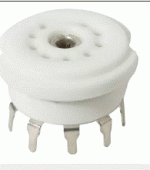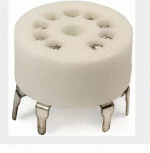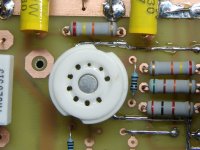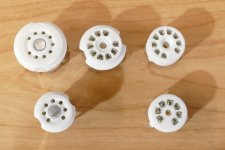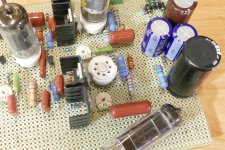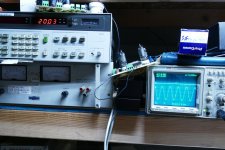If I remember correctly, I paid about $6.50 apiece for my RCA 6LR8s. I also have a small stash of Sears-branded 6LR8s, most likely re-marked Sylvanias, as they have the tip-off. The RCAs are probably Sylvanias, too. I have some GE tubes with smooth tops.
A couple of years ago I attempted to use a couple of Russian 6n2p tubes in a Chinese-made preamp PCB that came with ceramic 9-pin sockets. The 6n2p tubes were a scarily tight push-fit.... Russki Magnoval sockets, which will be kinda loose with the usual Novar tube.
From that, and your post quoted above, I'm guessing I should have actually had Russian Magnoval sockets to use the 6n2p tubes. A little brief searching hasn't led me to a source - can anyone kindly provide a link to a source for 9 pin sockets which will fit the pins on a 6n2p?
TIA,
-Gnobuddy
"can anyone kindly provide a link to a source for 9 pin sockets which will fit the pins on a 6n2p?"
https://www.ebay.com/itm/233594012934?
https://www.ebay.com/itm/233594012934?
Depends on whether you're looking for pcb mount or chassis mount. An Ebay search for "magnoval socket" turns up a lot of sources. The one you show is from USA, but likely Chinese sourced. The pin fit may be somewhat loosey-goosey for those. It was for the 9 pin PCB novar sockets I got off Ebay (probably from the same vendor). I have some chassis mount sockets from Russia that are a better fit with the magnoval pins. They are all ceramic, including the mounting ears, so a nylon washer along with the usual metal washer may be needed to prevent cracking.
Thank you!"can anyone kindly provide a link to a source for 9 pin sockets which will fit the pins on a 6n2p?"
https://www.ebay.com/itm/233594012934?
-Gnobuddy
Got a link to share, by any chance?wrenchone said:I have some chassis mount sockets from Russia that are a better fit with the magnoval pins.
I'm actually looking for PCB-mount sockets, but if chassis-mount sockets are a better fit for the Russian preamp tubes, I'd rather use those, with flying leads to the PCB.
TIA,
-Gnobuddy
"I'm actually looking for PCB-mount sockets, but if chassis-mount sockets are a better fit for the Russian preamp tubes, I'd rather use those, with flying leads to the PCB."
So then...
Have 10 Magnoval sockets I ordered for a Novar project that are unusable. I would sell them all for $10 plus the ride to Canada via usps.
I have Paypal account
Jim
So then...
Have 10 Magnoval sockets I ordered for a Novar project that are unusable. I would sell them all for $10 plus the ride to Canada via usps.
I have Paypal account
Jim
Wait a minute - the 6n2P is a miniature double triode that takes the 9-pin noval socket. There are scads of sources for those. I would advise to stay away from the pcb sockets with the tiny holes, as I have run into sockets where the holes are too small to pass the pins, making it near impossible to seat the tubes. Sockets with larger holes and the "sleeve" contacts generally work better.
If you don't mind plastic sockets, Antique Electronics has sockets for the 6n2P at about $1.50 apiece - should be quite suitable for a low-power tube like the 6n2p. Ebay also has a large number of vendors with suitable sockets.
Last edited:
Good catch-Wait a minute - the 6n2P is a miniature double triode that takes the 9-pin noval socket. There are scads of sources for those. I would advise to stay away from the pcb sockets with the tiny holes, as I have run into sockets where the holes are too small to pass the pins, making it near impossible to seat the tubes. Sockets with larger holes and the "sleeve" contacts generally work better.
My knowledge of european/russian tube #'s is not as strong as US #'s...
Thx for clarifying
Jim
I don't think that Gnobuddy would have a lot of luck plugging a teeny 6n2p into a magnoval socket, or even getting the socket to fit into the original holes. for the 6n2p. I think that he ran afoul of a socket with holes too small to pass the pins. I have had my share of problems with those riveted-together sockets with tiny holes on top - the quality control is spotty at best.
If you still have those magnoval sockets, I may have a use for them - I have been obsessively collecting 18GB5s, with the goal of possibly using them triode-connected in a push-pull amplifier. I have a pair of Electra-Print transformers that I think were originally set up to play with something like a 6B4G or 6S4S. I need to find the transformers and take them for a spin on my bench to check out the turns ratio and primary inductance.
Last edited:
Ah. That never occurred to me. Great catch, thanks very much!I think that he ran afoul of a socket with holes too small to pass the pins. I have had my share of problems with those riveted-together sockets with tiny holes on top - the quality control is spotty at best.
I wonder if I can open up those holes in the ceramic insulator just a hair with a masonry drill bit, if I can find one small enough?
-Gnobuddy
A mini tool with a carbide tip might do the trick. George/Tubelab mentioned a while back that he had to do that with some sockets where the holes for the pins were too small. I would just cut off the old sockets and replace them with something that works better - that's what I did with the ones that offended me previously.. That's also why I posted the pictures of sockets - both recommended and not recommended. A pair of good sockets won't exactly break the bank...
I use the chassis mount versions of Socket #1 all the time. The ones I’ve had trouble getting tubes into were the 7 pin variery. I had a few 9 pin that were seriously mis-shapen, but I just set those aside. They’re cheap enough that you don’t need 100% yield.
The 9-pin PC mount sockets that gave me trouble were type 1. I whacked them off the board with a pair of cutters and replaced them with type 2 sockets, which fit just fine. I have some 7-pin chassis-mount sockets from the Russkies - they are of type 1, but they have no fit problems, as the quality control for Russian military parts is far better. I think in retrospect that the sockets that gave George/tubelab problems were 7-pin. I have a bunch of bakelite PCB
7-pin sockets of type 2 that have no fit problems. You can also get the type 2 plastic 7-pin PCB sockets from Apex jr.
7-pin sockets of type 2 that have no fit problems. You can also get the type 2 plastic 7-pin PCB sockets from Apex jr.
The junk sockets were 9 pin "type 1s" from early 2006. This picture shows one of them in the first DIY prototype of what became the Simple Push Pull (SPP) board. The picture is dated June of 2006. Unfortunately, I did not see this until I tried to jam a 12AT7 into it. I went through the rest of them and found one more with small holes. Attempts to fix them with a Dremel tool usually resulted in a broken bit.
I have three types of 9 pin sockets and two types of 7 pin sockets. I have not used the riveted type 1 sockets in a long time except for "disposable" test boards or perf board prototypes. I learned to test fit a tube before using. The type 2 7 pin sockets that I have are almost too tight. Getting tubes in an out on a hand wired perf board proto results in broken solder connections. I have not tried them in a PCB yet but they would likely be OK.
This is a perf board prototype guitar amp that squeezes 20 watts from a pair of 50C5 radio tubes using UNSET technology. The black plastic 7 pin sockets that I got from AES many years ago start to smell funny when you beat the tubes that hard. 50C5's are a 50 volt 6W6 squeezed into a 7 socket. They run very hot and their recommended operating conditions are at 100% of max rated dissipation. There is also a 7.5 watt heater inside the cathode. This board was left running at the 20 watt level overnight. The next morning the power meter said 20.03 watts at 3.76% THD.
I have three types of 9 pin sockets and two types of 7 pin sockets. I have not used the riveted type 1 sockets in a long time except for "disposable" test boards or perf board prototypes. I learned to test fit a tube before using. The type 2 7 pin sockets that I have are almost too tight. Getting tubes in an out on a hand wired perf board proto results in broken solder connections. I have not tried them in a PCB yet but they would likely be OK.
This is a perf board prototype guitar amp that squeezes 20 watts from a pair of 50C5 radio tubes using UNSET technology. The black plastic 7 pin sockets that I got from AES many years ago start to smell funny when you beat the tubes that hard. 50C5's are a 50 volt 6W6 squeezed into a 7 socket. They run very hot and their recommended operating conditions are at 100% of max rated dissipation. There is also a 7.5 watt heater inside the cathode. This board was left running at the 20 watt level overnight. The next morning the power meter said 20.03 watts at 3.76% THD.
Attachments
- Home
- Amplifiers
- Tubes / Valves
- A Leap of Faith...
